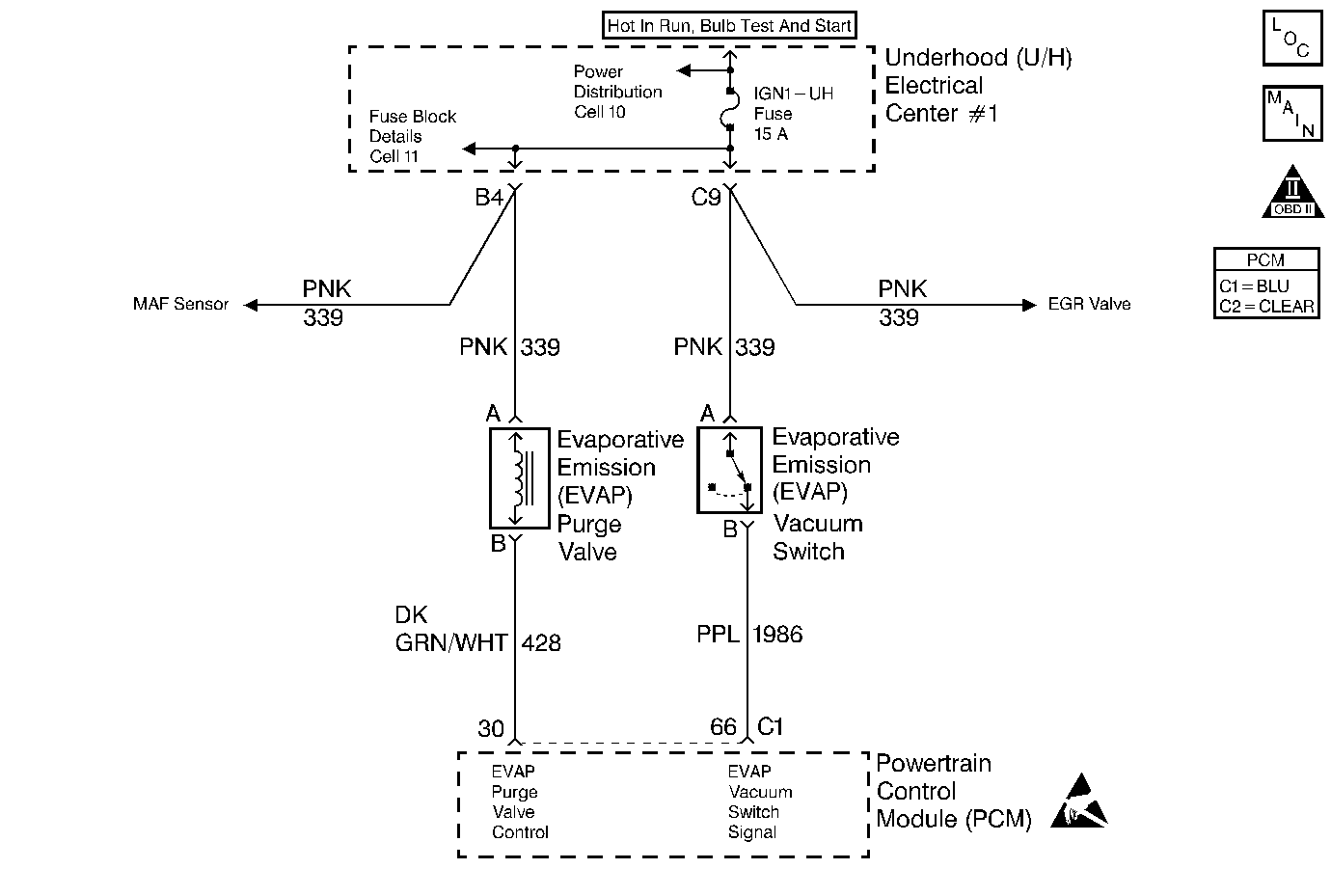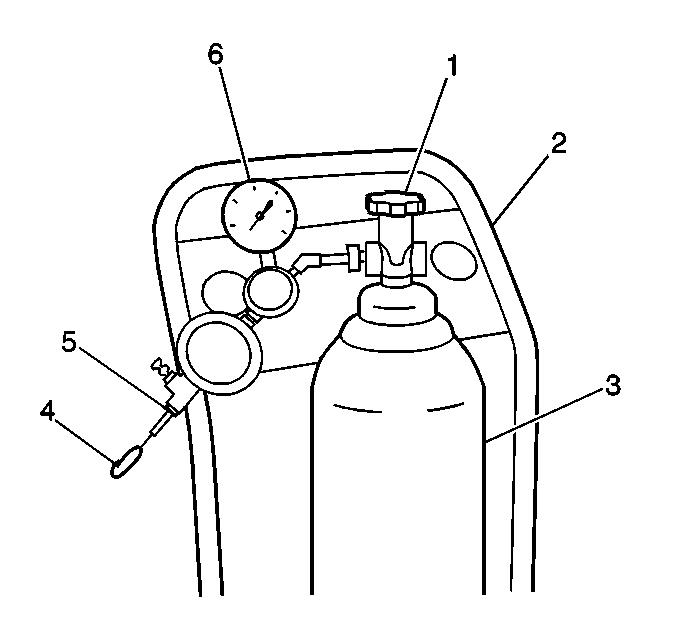
Circuit Description
The EVAP purge solenoid valve allows manifold vacuum to purge the canister. The Powertrain Control Module (PCM) supplies a ground to energize the EVAP purge solenoid valve (purge ON). The EVAP purge solenoid control is Pulse Width Modulated (PWM) or turned ON and OFF several times a second. The duty cycle (pulse width) is determined by engine operating conditions including load, throttle position, coolant temperature and ambient temperature. The duty cycle is calculated by the PCM and the output is commanded when the appropriate conditions have been met:
VIN 1
| • | Engine coolant temperature above 60°C (140°F). |
| • | After the engine has been running about 3 minutes on a cold start or 3 seconds on a warm start. |
| • | The vehicle is operating in closed loop fuel control. |
VIN K
| • | Engine coolant temperature above 50°C (122°F). |
| • | After the engine has been running about 3 minutes on a cold start or 45 seconds on a warm start. |
| • | The vehicle is operating in closed loop fuel control. |
Canister purge PWM duty cycle varys according to operating conditions determined by mass air flow, fuel trim, and. intake air temperature. Canister purge will be disabled if TP angle increases to above 70% (VIN 1) and 60% (VIN K) . Canister purge will be re-enabled when TP angle decreases below 66% (VIN 1) and 58% (VIN K) .
The EVAP purge vacuum switch is a normally closed switch positioned in the purge line between the canister and the EVAP purge solenoid. The EVAP purge vacuum switch will open when vacuum increases to greater than 5 inches of water in the purge line. The PCM monitors the EVAP purge vacuum switch signal to determine of the evaporative emission control system is working properly. If the switch is closed (no purge flow) when the PCM is commanding the EVAP purge solenoid ON, DTC P0441 will be set.
Conditions for Running the DTC
- No TP sensor, IAT sensor, MAP sensor, ECT sensor, or MAF sensor DTCs set.
- BARO reading is greater than 70 kPa.
- Throttle angle is between 3% and 40%.
- Engine Coolant Temperature is less than 114°C (237°F).
- Intake Air Temperature (IAT) sensor indicates an ambient temperature less than 70°C (158°F).
- The difference between ECT and IAT is less than 10°C (18°F).
- Engine speed is between 900 rpm and 5000 rpm.
- Canister purge PWM is greater than 85%.
Conditions for Setting the DTC
| • | EVAP vacuum switch remains closed (12 volts signal at the PCM). |
| • | Above conditions for longer than 4 seconds. |
Action Taken When the DTC Sets
| • | The PCM will illuminate the MIL during the second consecutive trip in which the diagnostic test has been run and failed. |
| • | The PCM will store conditions which were present when the DTC set as Freeze Frame and Fail Records data. |
Conditions for Clearing the MIL/DTC
| • | The PCM will turn the MIL OFF during the third consecutive trip in which the diagnostic has been run and passed. |
| • | The history DTC will clear after 40 consecutive warm-up cycles have occurred without a malfunction. |
| • | The DTC can be cleared by using the scan tool Clear Info function or by disconnecting the PCM battery feed. |
Diagnostic Aids
Check for the following conditions:
| • | Poor connection at the PCM. |
| Inspect harness connectors for backed out terminals, improper mating, broken locks, improperly formed or damaged terminals, and poor terminal to wire connection. |
| • | Damaged harness. |
| Inspect the wiring harness for damage. |
| • | If the harness appears to be OK, observe the EVAP vacuum switch display on the scan tool while moving connectors and wiring harnesses related to the sensor. A change in the display will indicate the location of the malfunction. |
| • | Malfunctioning or damaged canister. |
| A malfunctioning canister may intermittenly allow charcoal into the EVAP purge solenoid, vacuum switch, and associated lines causing a DTC to be set. Use the following procedure to check for a carbon release condition: |
| 1. | Turn OFF the ignition switch. |
| 2. | Remove the EVAP purge solenoid. Refer to Evaporative Emission Canister Purge Solenoid . |
| 3. | Remove the EVAP vacuum switch. Refer to Evaporative Emission Vacuum Switch . |
| 4. | Lightly tap the purge solenoid and (if applicable) the vacuum switch on a clean work area looking for carbon particles exiting either of the vacuum ports. |
| 5. | If no carbon release is evident, reinstall the components and continue with the DTC P0441 diagnostic table. If carbon is being released from either component, continue with this service procedure. |
| 6. | Remove the charcoal canister from the vehicle. |
| 7. | Ensure that the main cylinder valve is turned off on the

|
| 8. | Disconnect the black hose that connects the nitrogen cylinder to the EVAP purge/pressure diagnostic station at the pressure regulator by unscrewing the knurled nut on the regulator. No tools are required to remove the black hose from the regulator. |
| 9. | Using a section of vacuum line, connect one end over the open threaded fitting of the EVAP purge/pressure diagnostic station pressure regulator. |
| 10. | Connect the remaining end to the purge solenoid end of the EVAP purge line at the vehicle and turn on the main nitrogen cylinder valve. Continue to blow any debris from the purge line for 15 seconds. |
| 11. | Return the EVAP Pressure/Purge Diagnostic Station to its original condition by re-installing the black hose that was disconnected in step 8. |
| 12. | Replace the following components: |
| • | The EVAP purge solenoid. Refer to Evaporative Emission Canister Purge Solenoid . |
| • | The EVAP canister. Refer to Evaporative Emission Canister Replacement . |
| • | The EVAP vacuum switch. Refer to Evaporative Emission Vacuum Switch . |
| 13. | Proceed with the DTC P0441 diagnostic table. |
Reviewing the Fail Records vehicle mileage since the diagnostic test last failed may help determine how often the condition that caused the DTC to be set occurs. This may assist in diagnosing the condition.
Test Description
Number(s) below refer to the step number(s) on the Diagnostic Table .
Step | Actio n | Value(s) | Yes | No | ||||
|---|---|---|---|---|---|---|---|---|
1 | Was the Powertrain On-Boar d Diagnostic (OBD) System Check performed? | -- | ||||||
2 |
Does the EVAP Vacuum Sw. display Purge with the EVAP purge valve commande d ON? | -- | ||||||
3 |
Note test result; does scan tool indicate DTC P0441 failed this ign ? | -- | Refe r to Diagnostic Aids | |||||
4 |
Does the scan tool display Purge? | -- | ||||||
5 | Check the vacuum lines to the EVA P canister for damage or improper connections. Refer to Emission Hose Routing Diagram . Was a problem found? | -- | ||||||
6 |
Does the gauge indicate vacuum greater than the specified value? | 12 in. Hg | ||||||
7 |
Does the scan tool display Purge? | -- | ||||||
8 |
Does the gauge indicate vacuum greater than the specified value? | 12 in. Hg | ||||||
9 |
Was a problem found? | -- | ||||||
10 |
Is the test light ON? | -- | ||||||
11 |
Is the test light ON? | -- | ||||||
12 | Check for a poor connection at the PCM. Was a problem found? | -- | ||||||
13 |
Is action complete? | -- | -- ; | |||||
14 | Replace the EVAP canister . Go to Evaporative Emission Canister Replacement . Important: Check for carbon release into the EVAP system. Refer to Diagnostic Aids . Is action complete? | -- | -- ; | |||||
15 | Replace the EVAP vacuu m switch. G o to Evaporative Emission Vacuum Switch Important: Check for carbon release into the EVAP system. Refer to Diagnostic Aids . Is action complete? | -- | -- ; | |||||
16 | Locate and repai r the cause of no vacuum. Important: Check for carbon release into the EVAP system. Refer to Diagnostic Aids . Is action complete? | -- | -- ; | |||||
17 |
Was a problem found? | -- | ||||||
18 | Replace the EVAP purge valve . Go to Evaporative Emission Canister Purge Solenoid Important: Check for carbon release into the EVAP system. Refer to Diagnostic Aids . Is action complete? | -- | -- ; | |||||
Replace th e PCM. Important:: The replacement PCM must be programmed. Go to Powertrain Control Module Replacement/Programming . Is action complete? | -- | -- ; | ||||||
20 |
Note test result; does the scan tool indicate DTC P0441 failed thi s ign? | -- | Syste m OK |
